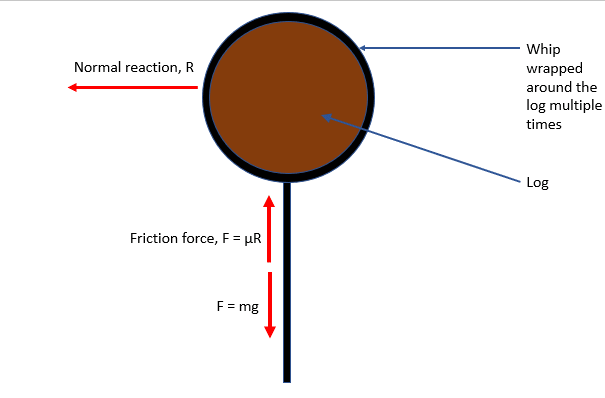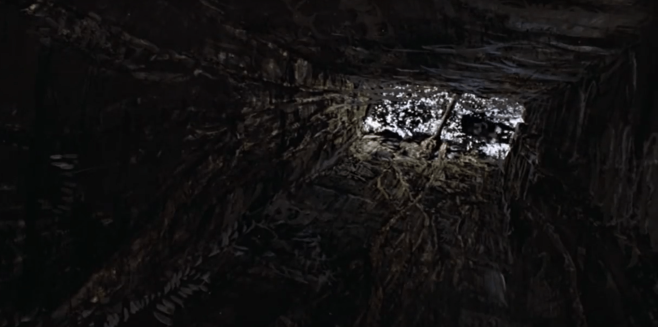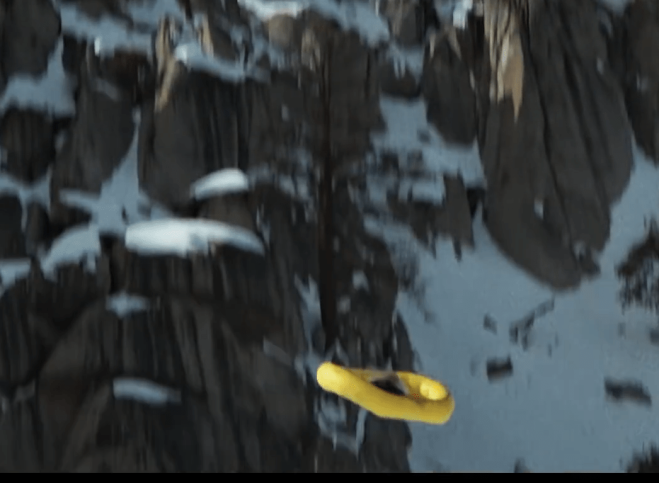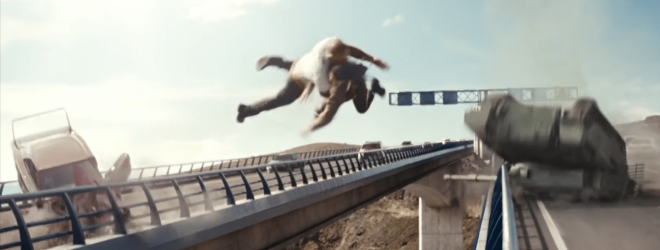Steven Spielberg, 1981- , rated 12 and below by bbfc
The Indiana Jones franchise contains 5 films with the first one coming out in 1981 and the last one being released in 2008, another film is planned for 2020. The franchise’s main protagonist is Dr. Henry Walton “Indiana” Jones Jr. who is portrayed by Harrison Ford. Indiana Jones or Indy is a professor of archaeology who investigates ancient civilizations mostly involving the supernatural. He often finds himself in dangerous situations, ranging from rolling boulders to fighting the Nazis, a lot of the films do test the laws of physics. Let’s see if they go too far or remain in the realms of possibility.
In the first film, The Raiders of the Lost Ark, there is a scene in which Indy is attempting to gain entry into an ancient temple. He comes across a chasm, with a log hanging right in the middle of the gap. He wraps his trusty bullwhip around the log by whipping it and then uses it to swing himself across the gap to the other side.

Whether or not this is possible comes down to friction, can the frictional force between the whip and the log, as well as the friction between the whip and other parts of the whip create a large enough force to hold the weight of Indy. Friction depends on the normal force and the friction coefficient, μ.

Now we need the frictional force, F = μR to be equal to the weight of Indy. μ is dependent on the roughness of both the whip and the log, the rougher the two surfaces the higher the value of μ. Both the whip and the log look rough in the film so it does have the highest possible chance of success. The whip and log are also in contact at lots of point as well as the whip being in contact with itself at lots of points meaning that the frictional force could actually be high enough for this to be possible. Once we accept that the force from the friction can be high enough to hold Indy’s weight it’s a simple case of Indy swinging himself across, to do this he has to become a simple pendulum, the two ledges are at the same height so it should be relatively easy for Indy to reach the other side. Them being at the same height means that the gravitational potential energy is the same at both ledges so Indy doesn’t even need to add any kinetic energy. These findings are supported in Mythbuster’s episode 224 where they attempt to do it for real and find it to be plausible in the real world.

Another scene in the franchise that really pushes the boundaries of physics occurs in Indiana Jones and the Kingdom of the Crystal Skull, the most recent film. In the scene Indy finds himself in a Nevada dessert about to experience a test of an atomic bomb he is in a fake city ready to be destroyed, complete with dummies. He thinks quickly and gets into a Lead lined fridge in an attempt to survive the explosion, he survives this unscathed but how would this hold up to the physics of the real world.

Once he gets in and shuts the door we see the effects of the explosion, including the dummies burning, then the shockwave arrives destroying all the buildings and sending the fridge flying past a speeding car trying to escape, the car subsequently gets destroyed in the blast.

Now since this film was set in 1957 and it appears to be Nevada we can actually estimate the power of the bomb and even the actual operation the test bomb was a part of, there were a set of test nuclear operations called Operation Plumbbob that occurred in the Nevada desert in the same time period as the film in the same location. We can also see that it’s a ‘tower drop’ this means that the yield will have to be somewhere between 10 Kilotons and 44 kilotons. Now we can look at how fast the fridge is moving, the best way to do this is to look at how long it takes the fridge to go past the car, this will obviously include some more assumptions; we are gonna estimate the car as 2 metres long, and assume that it’s travelling at least 70 miles per hour (approximately 30 metres per second), one more thing we need to work out from the clip is how long it takes for the fridge to go past the car, we measured it to be 0.5 seconds. So what velocity does this give for the fridge, 
where the subscripts f and c indicate the velocities of the fridge and the car and l is the length of the car and t the time taken for the fridge to overtake the car. When using all our values from above we actually get a value of 34 metres per second for the velocity of the fridge.
This is only the horizontal velocity of the fridge it has also been accelerated in the vertical direction but we will ignore this, so all estimates for forces from now on will actually be more like lower estimates. We now need to look at the mass of the fridge with Indy in it, we will say that Indy weighs 90 kilograms and the fridge ≈70 kilograms from looking at similar fridges from the same time period. We now need to know how long the shockwave acted on the fridge for and this will then gives us an estimate for the amount of acceleration the fridge and Indy experienced. The shockwaves for atomic bombs can produce speeds in excess of ∼300 metres per second, however to again provide a lower estimate we have gone with 250 metres per second as a rough estimate. We now only need the length of the fridge which looks to be around 0.7 metres. The time that the shockwave acted upon the fridge for is 
this gives us a time of 2.8 milliseconds for the shockwave to act upon the fridge (note that we are assuming the shockwave is moving parallel to the fridge). Using this we can finally calculate the acceleration of the fridge and therefore Indy, 
using 34 metres per second for the velocity change and 2.8 milliseconds for the time taken, we get the acceleration to be ≈ 12100 metres per second squared or 1200 g’s comfortably enough to kill Indy, in a car crash anything more than 80 g’s is taken to be certain death so 1200 g’s is beyond an unlikely survival especially given the most g’s ever recorded and survived by a human is only 214 g’s. This doesn’t even include the heat of the blast effecting the shape of the fridge and the deceleration of the landing which would certainly kill Indy. So this scene really does ignore basic laws of physics in exchange for a good scene visually.
In a scene in Indiana Jones and the Temple of Doom, Indy, his 11 year old sidekick Short Round and nightclub singer Willie Scott find themselves in a plane that is going down without any parachutes. Indy gets all three of them to climb into an inflatable raft, pulls the chord so it begins to inflate before jumping out of the plane with the raft. The raft inflates mid air and they all land safely on the snowy mountain before sliding their way down the mountain. Let’s look at this from a physics standpoint.

Let’s see if the fall would have been survivable, it comes down to air resistance and what air resistance the raft experiences on the way down from the plane. We will assume that the raft and it’s passengers reach terminal velocity before they hit the ground, there are also a couple of other assumptions we have to make. We are going to assume that the raft is a flat plate so it has a drag coefficient of ≈1.3, we also estimate the area of the bottom of the raft to be 3 metres squared after looking at the clip and other similar rafts (length of 3 metres and width of 1 metre). Finally we have to estimate the weight of the raft and it’s passengers, we are going to take the weight of the raft to be 45 kilograms as that is very similar to other rafts of similar sizes and we will say that Indy weighs 90 kilograms, Willie 50 kilograms and Short round 40 kilograms. Now for this we are going to use the air resistance equation  where ρ=1.2 kilograms per metre cubed, the drag coefficient and area are as we said earlier. We now need to set the force from the air resistance equal to the force from gravity, F = mg, where m is 224 kilograms. Rearranging we get
where ρ=1.2 kilograms per metre cubed, the drag coefficient and area are as we said earlier. We now need to set the force from the air resistance equal to the force from gravity, F = mg, where m is 224 kilograms. Rearranging we get  this gives us a velocity of ≈31 metres per second. If we look at experimentation done by NASA into impacts on snow, they actually found that humans have tolerated impacts at velocities of 53.6 metres per second without serious injuries when landing on snow. The fact that they are in a raft would lower the deceleration and therefore the forces experienced by Indy and his friends. This all leads us to believe that this scene is incredibly reasonable as long as the raft doesn’t flip in the air while it is trying to inflate and that it has definitely inflated in time for it too slow itself down.
this gives us a velocity of ≈31 metres per second. If we look at experimentation done by NASA into impacts on snow, they actually found that humans have tolerated impacts at velocities of 53.6 metres per second without serious injuries when landing on snow. The fact that they are in a raft would lower the deceleration and therefore the forces experienced by Indy and his friends. This all leads us to believe that this scene is incredibly reasonable as long as the raft doesn’t flip in the air while it is trying to inflate and that it has definitely inflated in time for it too slow itself down.
Throughout the films there are obviously some very large liberties taken with the laws of physics, however there is an attempt to get basic scientific principles correct throughout the films even if the execution of these principles does often leave things to be desired.
The Indiana Jones films therefore get a rating of 7/10 for accuracy:

So we have looked in depth at a couple of key scenes in the Indiana Jones films and the physics behind them as well as giving them our rating on accuracy, but we would also like your input on how accurate you think the Indiana Jones films are in their use of physics, so it would be great if you could vote in our poll.
References:
Image of Indy’s whip wrapped around the log, Image of Indy closing the fridge, Image of the fridge going flying past the car, Image of the raft mid-air – all screen grabs off youtube movie clips channel.
Power of atomic bomb tests – https://en.wikipedia.org/wiki/Operation_Plumbbob
Blast speed of shock waves for nuclear explosions – https://en.wikipedia.org/wiki/Effects_of_nuclear_explosions
g-force survival – https://en.wikipedia.org/wiki/G-force
weight of inflatable raft – http://www.saturnrafts.com/technical-specs-boat.html
diagram describing friction – http://www.schoolphysics.co.uk/age16-19/Mechanics/Statics/text/Friction_/index.html
Survival of impact with snow – https://ntrs.nasa.gov/archive/nasa/casi.ntrs.nasa.gov/19930020462.pdf





 so plugging this into our equation for the force from air resistance and setting it equal to mg, we get the required diameter of the parachute to be
so plugging this into our equation for the force from air resistance and setting it equal to mg, we get the required diameter of the parachute to be

 where the subscripts f and i indicate the final and initial velocities, a is the acceleration and d is the distance Dom and Letty were decelerating for. Plugging in the estimates from above and a final velocity of zero, we get an acceleration of ≈1960 metres per second squared or 200 g’s. To put that into context we make the following graph,
where the subscripts f and i indicate the final and initial velocities, a is the acceleration and d is the distance Dom and Letty were decelerating for. Plugging in the estimates from above and a final velocity of zero, we get an acceleration of ≈1960 metres per second squared or 200 g’s. To put that into context we make the following graph, 
